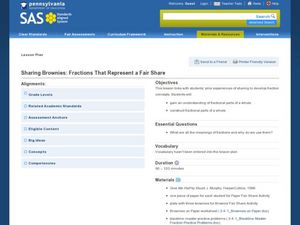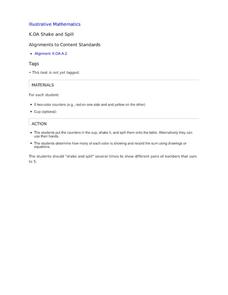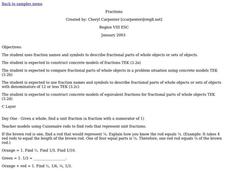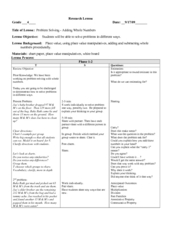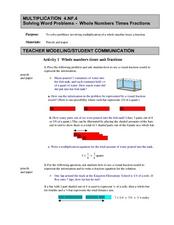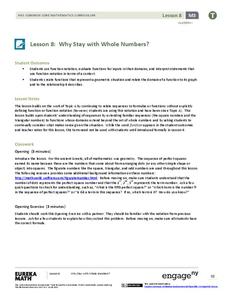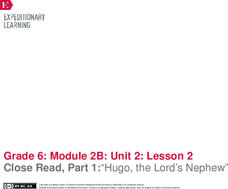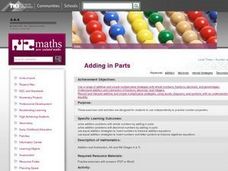Curated OER
Sharing Brownies: Fractions That Represent a Fair Share
Elementary graders discover the concept of fractional pieces of a whole. They investigate the meanings of fractions in everyday life and why they are used. Pupils divide brownies amongst each other to demonstrate the use of fractions...
Curated OER
Putting the Pieces Together
Children explore fractions on a conceptual level by making individual quilt squares. Each student works with small paper swatches to divide them into pieces that represent a given fraction. The class is then separated into groups and...
Curated OER
Fractions of A Pizza
Learners view a large illustration of a pizza with parts of velcro. For this addition and subtraction of fractions lesson, students solve problems based on the pieces missing from the pizza. Learners take a fraction quiz. Order a...
Illustrative Mathematics
Shake and Spill
Entertaining as well as educational, this math activity about decomposing numbers is bound to capture the engagement of young learners. Given a cup and five two-color counters, young mathematicians simply shake and spill the cup,...
Curated OER
Fractions
Young mathematicians use fraction names and symbols to describe fractional parts of whole objects or sets of objects. They construct concrete models of fractions, and compare fractional parts of whole objects in a problem situation using...
Curated OER
Problem Solving - Adding Whole Numbers
In order to practice problem-solving skills, pupils work through a series of word problems. They each determine an answer and then share their thinking process with the class. This instructional activity demonstrates that there may be...
Fraction Bars
Solving Word Problems - Whole Numbers Times Fractions
An impressive instructional activity where pupils visualize models and solve problems involving multiplying a whole number times a fraction. Fraction bars are used to help learners truly understand what's happening during this...
Fraction Bars
Quotients of Whole Numbers that Equal Fractions
A complete lesson on dividing whole numbers by other whole numbers and getting a fraction result. Groups of learners use fractions bars, and strips of paper that are cut to specific lengths. The hands-on activities in the lesson are...
Digital Forsyth
Parts of a Whole
High school artists create a collaborative piece based on a historical image. Each member of the class is given two days to draw one part of the whole image, when the two days are up; they put their pieces together and discuss the...
EngageNY
Interpreting Division of a Whole Number by a Fraction—Visual Models
Connect division with multiplication through the use of models. Groups solve problems involving the division of a whole number by a fraction using models. The groups share their methods along with the corresponding division and...
Illustrative Mathematics
How Many Servings of Oatmeal?
Here is another way to illustrate division of a whole number by a unit fraction. In this case, the problem is asking if there are so many servings per cup, how many servings are in a package of multiple cups. Learners are to model their...
EngageNY
Why Stay with Whole Numbers?
Domain can be a tricky topic, especially when you relate it to context, but here is a instructional activity that provides concrete examples of discrete situations and those that are continuous. It also addresses where the input values...
Illustrative Mathematics
Cooking with the Whole Cup
Whoops! Travis accidentally put too much butter into the recipe. Your bakers must find out how to alter the recipe to accommodate different changes by using unit rates and ratios . The activity has multiple parts and calculations with...
Turabian Teacher Collaborative
Parts of Argument II: Article Critique
Break down the parts of argumentative writing with a critical thinking activity. High schoolers read an article of your (or their choice), and use a graphic organizer to delineate the ways the author structures his or her arguments.
EngageNY
Construct an Equilateral Triangle (part 1)
Drawing circles isn't the only thing compasses are good for. In this first installment of a 36-part series, high schoolers learn how to draw equilateral triangles by investigating real-world situations, such as finding the location of a...
Teach Engineering
Nanotechnology as a Whole
It's a small (nanotechnology) world after all! The first segment of a six-part series gives an overview of nanotechnology, its principles and applications, and shares some of the engineering applications of nanotechnology. A...
Missouri Department of Elementary
Conflict Mediation – Part 1: Getting Ready
Two scholars walk into a room arguing, what is happening? Peers observe the two actors in preparation for a whole-class discussion about conflict. Learners establish a conflict, name the three approaches—passive, aggressive, and...
Missouri Department of Elementary
Safe and Healthy Life Choices (Part I)
As high schoolers seek to grow more and more independent, they must constantly make choices. Some options are healthy and some not so much. To begin the discussion, class members are asked to identify five safe and healthy (or...
EngageNY
Close Read, Part 1: “Hugo, the Lord’s Nephew”
Fourth time is a charm. Learners complete multiple reads of Hugo, the Lord’s Nephew. On the fourth read, they make notes about each page on sticky notes. They then complete a think-pair-share activity with a partner to determine the...
Curated OER
Understanding Fractions
Students explore the parts of an orange to develop an understanding of the addition and subtraction of fractions. The concept of representing parts of a whole by dividing an object into smaller pieces is experienced in this hands-on...
Curated OER
Fractions lesson 1
Young scholars are given an overview of fractions using fractions manipulatives. Students comprehend what numerators and denominators are. They demonstrate a clear comprehension that the size of a fraction depends on the number of parts...
Curated OER
Adding in Parts
Third graders are able to split whole numbers into parts. They make numbers up to a tidy number. Students add and subtract tenths to make a decimals number into a whole number. They are able to add whole numbers up to three digits.
Curated OER
Finding Total Given Part and Percentage
Students observe models of fractional parts. After writing the definitions of percent, part and whole, students use the calculators and computers to solve problems. Individually, they complete assigned problems where the convert the...
Community Resources for Science
A Whole New World of DNA and Proteins
Lead your young scientists into an exciting world as they participate in a role play and experiment focused on proteins and DNA. After researching the Central Dogma of Biology, individuals or groups participate in a classroom...
Other popular searches
- Fractions Parts and Wholes
- Math Parts and Wholes
- Wholes and Parts
- Fractions Parts of Wholes
- Parts and Wholes Science
